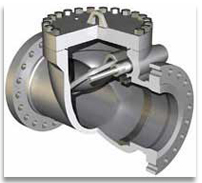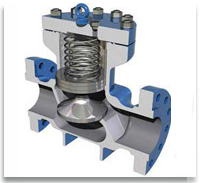Check Valve

Check valve are "automatic" valves that open with forward flow and close with reverse flow. The pressure of the fluid passing through a system opens the valve, while any reversal of flow will close the valve. Exact operation will vary depending on the type of Check valve mechanism. Most common types of Check valve are swing, lift (piston and ball), butterfly, stop and tilting-disk.We are an ISO 9001:2008,ISO 9001-2008, ISO 14001-2004, OHSAS 18001-2007, NSIC-CRISIL, EEPC, and QA-UKAS (ISO 9001-2008), SSI Certified company that follows total Quality Management System. and have been recognized as one of the world’s leading stockists and manufacturer of quality metals for over two decades and are committed to quick responses, unsurpassed quality, competitive pricing, reliable deliveries and an exhaustive inventory.
Check valve Specification
| Type | Check valve |
| Standred | DIN 3352 F5 |
| Material | Industrial-grade steel, carbon steel, stainless steel, alloy steel and special steel |
| Size | DN50-DN400 |
| Diameter | 1”to13” |
| Order | Accept custom order |
Construction of a Check valve:
A basic check valve consists of a valve body, bonnet or cover, and a disc which is attached to a hinge and swings away from the valve seat to allow fluid to flow in the forward direction, as in a swing- or tilting-disc check valve, and returns to valve seat when upstream flow is stopped. Thus, reverse flow is prevented. In folding disc check valves, the disc consists of two halves attached in the middle. The two halves fold backward when upstream flow is initiated. Activated by a spring, the two halves quickly close the flow path when upstream flow ceases. In the case of lift-check valves, the disc is in the form of a piston which is moved out of the flow path by upstream flow and returns to the valve seat by gravity to stop back flow. Ball-check valves have a disc in the form of a ball.
Advantages and disadvantages of Check valve:
Advantages:
They are self-actuated and require no external means to actuate the valve either to open or close. They are fast acting.
Disadvantages:
• Since all moving parts are enclosed, it is difficult to determine whether the valve is open or closed. Furthermore, the condition of internal parts cannot be assessed.• Each type of check valve has limitations on its installation configurations.
• Valve disc can stick in open position.
Types of Check valves:
Check valve have a very distinct globe shape. The disk, valve stem, and the hand wheel are the moving parts in the valve body. The body is available in three different designs depending on the application as well as three different types of disks.


A basic swing Check valve consists of a valve body, a bonnet, and a disk that is connected to a hinge. The disk swings away from the valve-seat to allow flow in the forward direction, and returns to valve-seat when upstream flow is stopped, to prevent back flow. The disc in a swing type Check valve is unguided as it fully opens or closes. There are many disk and seat designs available, in order to meet the requirements of different applications. The valve allows full, unobstructed flow and automatically closes as pressure decreases. These valves are fully closed when flow reaches zero, in order to prevent back flow. Turbulence and pressure drop in the valve are very low.
Lift Check valve
The seat design of a lift-Check valve is similar to a Globe valve. The disc is usually in the form of a piston or a ball.Lift Check valves are particularly suitable for high-pressure service where velocity of flow is high. In lift Check valves, the disc is precisely guided and fits perfectly into the dash pot. Lift Check valves are suitable for installation in horizontal or vertical pipe-lines with upward flow.Flow to lift Check valves must always enter below the seat. As the flow enters, the piston or ball is raised within guides from the seat by the pressure of the upward flow. When the flow stops or reverses, the piston or ball is forced onto the seat of the valve by both the back flow and gravity.
Packaging Of Check valve:
1.Hessian / PVC Cloth Bundles with PVC Box Strap or Hexagonal Bundles2.Wooden Crate
3.Wooden Box made of treated wood or Plywood sheet
4.Bundles (hexagonal)
5.Crates (steel/wooden)
6.Special Crates
Application Of Check valve:
1.Food Industries2.Water Industries
3.Oil & Gas Industries
4.Automotive Industries
5.Ship Building Industries
6.Petro-Chemical Industries
7.Engineering Cement Industries
8.Transport Industries-Rail and Road
9.Chemical & Pharmaceutical Industries
10.Construction Industries / Building Systems
